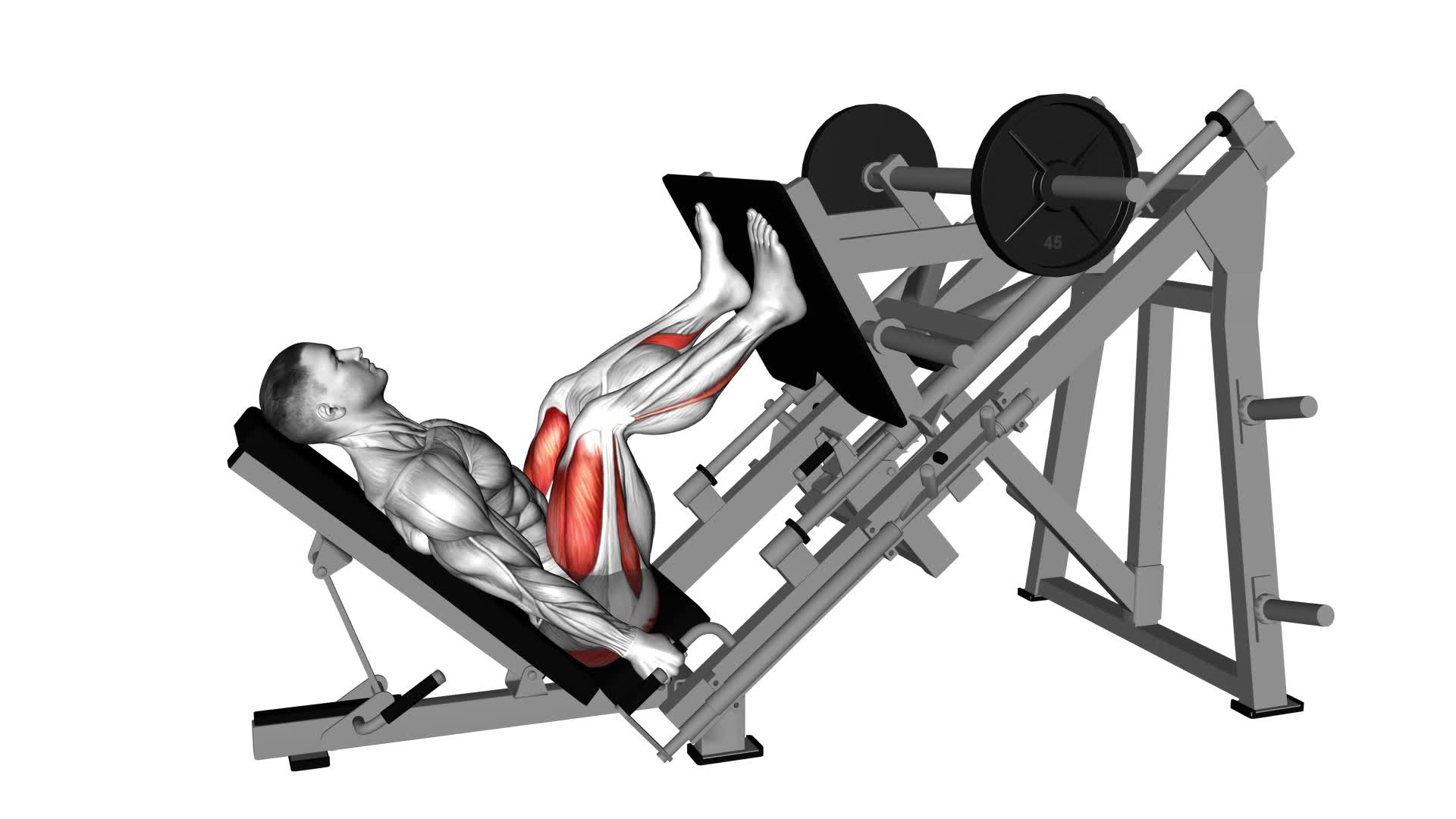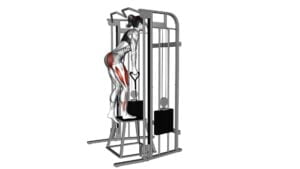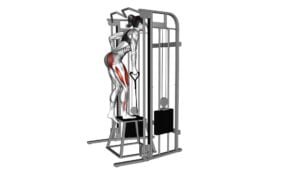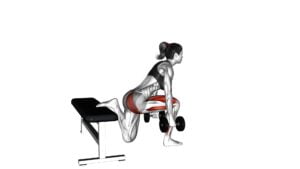Sled Glute Dominant Leg Press (male) – Video Exercise Guide & Tips

Are you looking for a targeted leg exercise that will help you build strong glutes? Look no further than the sled glute dominant leg press.
Watch This Exercise Video
In this exercise, you'll be able to engage your glute muscles while also working your legs. With proper form and technique, you can effectively strengthen and tone your lower body.
In this article, we'll provide you with a video exercise guide and helpful tips to get the most out of your sled glute dominant leg press workout.
Key Takeaways
- The Sled Glute Dominant Leg Press targets and strengthens the glute muscles, leading to significant glute activation and strength gains.
- Proper form and technique, such as maintaining stable posture and avoiding rounding the back or letting knees cave inwards, are crucial during the exercise.
- Common misconceptions include thinking that the leg press only targets the quadriceps and neglecting the importance of maintaining proper form.
- Variations and modifications, such as adjusting foot placement and incorporating single-leg variations, can target different muscles and adjust intensity levels.
Benefits of the Sled Glute Dominant Leg Press
You will experience significant glute activation and strength gains with the Sled Glute Dominant Leg Press. This exercise specifically targets the glute muscles, helping to activate and strengthen them. When performing the Sled Glute Dominant Leg Press, your glute muscles are thoroughly engaged, allowing for maximum muscle activation. This is due to the positioning and movement involved in the exercise.
As you push the sled away with your legs, your glutes are the primary muscles responsible for generating the force needed to move the weight. This constant tension and resistance on the glutes lead to increased muscle activation, ultimately resulting in stronger and more defined glute muscles.
In addition to glute activation, the Sled Glute Dominant Leg Press also offers significant strength gains. By consistently incorporating this exercise into your training routine, you can expect to see improvements in your overall leg and lower body strength. The resistance provided by the sled allows you to progressively overload your muscles, challenging them to adapt and grow stronger over time. As a result, you'll experience increased strength in your glutes, hamstrings, quadriceps, and even your core muscles.
Proper Form and Technique for the Exercise
To perform the Sled Glute Dominant Leg Press with proper form and technique, maintain a stable and upright posture throughout the exercise. Here are some key points to keep in mind:
- Position your feet shoulder-width apart on the sled platform, with your toes pointing slightly outward. This will engage your glutes and hamstrings effectively.
- Slowly lower the sled by bending your knees and hips, keeping your back straight and your core engaged. Avoid rounding your back or letting your knees cave inwards.
- Press through your heels as you extend your legs, pushing the sled away from your body. Focus on using your glutes and hamstrings to power the movement.
Common misconceptions about the Sled Glute Dominant Leg Press include thinking it only targets the quadriceps or neglecting the importance of maintaining proper form. Remember that this exercise primarily targets the glutes and hamstrings while also engaging the quadriceps.
If you're looking for alternative exercises to target the same muscle groups, consider exercises like Romanian deadlifts, hip thrusts, or glute bridges. These exercises can provide a similar glute and hamstring activation while offering some variety to your routine.
Variations and Modifications to Target Different Muscles
To target different muscles, consider incorporating variations and modifications into your Sled Glute Dominant Leg Press routine. By adjusting your foot placement on the sled, you can activate different muscle groups and correct any muscle imbalances.
To emphasize glute activation, place your feet higher on the sled, towards the top portion. This will shift the focus onto your glutes and hamstrings, allowing for a more intense workout for these muscles. Additionally, try widening your stance to further engage your glutes.
If you want to target your quadriceps more, position your feet lower on the sled, towards the bottom portion. This will increase the load on your quadriceps and provide a challenging workout for these muscles. To further intensify the exercise, try narrowing your stance.
To correct any muscle imbalances, use single-leg variations of the sled glute dominant leg press. This will allow you to focus on each leg individually and ensure that both sides are equally trained. Start by pressing with one leg at a time, then switch to the other leg.
Incorporating these variations and modifications into your sled glute dominant leg press routine will help you target specific muscles, activate your glutes, and correct any muscle imbalances. Remember to adjust your foot placement and stance accordingly to achieve the desired results.
Common Mistakes to Avoid During the Leg Press
Avoiding common mistakes during the leg press is crucial for maximizing your results and preventing injury. Here are three common mistakes to avoid:
- Improper breathing technique: Many people tend to hold their breath or exhale forcefully during the leg press. This can increase intra-abdominal pressure and put unnecessary strain on your lower back. Instead, focus on maintaining a steady and controlled breath throughout the exercise. Inhale as you lower the weight and exhale as you push it back up.
- Skipping warm-up exercises: Neglecting to warm up properly before the leg press can lead to muscle stiffness and potential injury. Prior to starting the leg press, it's important to engage in dynamic warm-up exercises such as lunges, squats, or leg swings. This will increase blood flow to the muscles, improve range of motion, and prepare your body for the upcoming workout.
- Incorrect foot placement: Placing your feet too high or too low on the platform can affect the targeting of your leg muscles and increase the risk of injury. To ensure proper form and engagement of the targeted muscles, position your feet shoulder-width apart on the platform with your heels flat and toes pointing slightly outward.
Tips for Progression and Increasing Intensity
To gradually increase the difficulty of the leg press and challenge your muscles, it's important to progressively add weight and adjust your repetitions and sets. By implementing effective progression techniques, you can continually push yourself to new intensity levels and achieve optimal results.
One technique to consider is increasing the weight lifted during each session. Start with a weight that challenges you but allows you to maintain proper form. As you become stronger, gradually increase the weight to keep pushing your muscles to adapt and grow. Aim for small increments, such as 5-10 pounds, to ensure steady progress.
Another way to increase intensity is by adjusting your repetitions and sets. Initially, you may start with a lower number of repetitions and sets to build a foundation. As your strength improves, gradually increase both the number of repetitions and sets to continue challenging your muscles. This can be done by adding an extra set or increasing the number of repetitions in each set.
It is also beneficial to incorporate advanced techniques, such as drop sets or supersets, to further intensify your leg press workouts. Drop sets involve performing a set with a heavy weight, then immediately reducing the weight and performing another set until failure. Supersets involve performing two different exercises back-to-back without rest, targeting different muscle groups.
Remember to listen to your body and progress at a pace that's comfortable for you. By implementing these progression techniques and adjusting intensity levels, you can maximize the benefits of your leg press workouts and achieve your fitness goals.
Frequently Asked Questions
How Many Sets and Reps Should I Do for the Sled Glute Dominant Leg Press?
To determine the number of sets and reps for the sled glute dominant leg press, you should consider your fitness level and goals. Generally, it's recommended to start with 3-4 sets of 8-12 reps.
However, if you're experiencing knee pain, it's crucial to listen to your body and adjust accordingly. Lowering the weight or decreasing the number of reps might alleviate discomfort.
Always prioritize proper form and consult with a fitness professional if needed.
Can I Do the Sled Glute Dominant Leg Press if I Have Knee Pain?
If you have knee pain, it's best to avoid the sled glute dominant leg press. Putting pressure on your knees could worsen the pain.
Instead, try modifying the exercise or doing alternative glute exercises that don't strain your knees.
Consult with a fitness professional or physical therapist for specific modifications and exercises that can help you target your glutes without aggravating your knee pain.
Remember to prioritize your safety and listen to your body.
Is It Better to Use a Lighter Weight and Higher Reps or a Heavier Weight and Lower Reps for This Exercise?
When it comes to the sled glute dominant leg press, you might be wondering if it's better to use a lighter weight with higher reps or a heavier weight with lower reps. Well, the answer depends on your goals.
Using a lighter weight and higher reps can help increase muscle endurance and improve cardiovascular fitness.
On the other hand, using a heavier weight and lower reps can help build strength and muscle mass.
Consider what you want to achieve and adjust your approach accordingly.
Can I Do the Sled Glute Dominant Leg Press if I Have a Lower Back Injury?
If you have a lower back injury, it's important to be cautious when doing the sled glute dominant leg press. Modify the exercise by using lighter weights and focusing on proper form. Avoid any movements or positions that cause pain or discomfort in your lower back.
Additionally, there are alternative exercises you can try to target your glutes without aggravating your injury, such as glute bridges or hip thrusts.
Always consult with a healthcare professional before starting any new exercise program.
How Often Should I Include the Sled Glute Dominant Leg Press in My Workout Routine?
To determine how often to include the sled glute dominant leg press in your workout routine, consider your fitness goals and overall training program.
It's generally recommended to perform this exercise 2-3 times per week, allowing for adequate rest and recovery between sessions.
As for sets and reps, aim for 3-4 sets of 8-12 repetitions to effectively target your glutes and legs. Adjust the weight and intensity based on your strength and ability.
Conclusion
In conclusion, the sled glute dominant leg press is a highly effective exercise for targeting and strengthening the glute muscles. By maintaining proper form and technique, individuals can maximize the benefits and avoid common mistakes.
Additionally, incorporating variations and modifications can help target different muscles and increase intensity.
With consistent practice and progression, this exercise can contribute to overall lower body strength and stability.

Author
Years ago, the spark of my life’s passion ignited in my mind the moment I stepped into the local gym for the first time. The inaugural bead of perspiration, the initial endeavor, the very first surge of endorphins, and a sense of pride that washed over me post-workout marked the beginning of my deep-seated interest in strength sports, fitness, and sports nutrition. This very curiosity blossomed rapidly into a profound fascination, propelling me to earn a Master’s degree in Physical Education from the Academy of Physical Education in Krakow, followed by a Sports Manager diploma from the Jagiellonian University. My journey of growth led me to gain more specialized qualifications, such as being a certified personal trainer with a focus on sports dietetics, a lifeguard, and an instructor for wellness and corrective gymnastics. Theoretical knowledge paired seamlessly with practical experience, reinforcing my belief that the transformation of individuals under my guidance was also a reflection of my personal growth. This belief holds true even today. Each day, I strive to push the boundaries and explore new realms. These realms gently elevate me to greater heights. The unique combination of passion for my field and the continuous quest for growth fuels my drive to break new ground.







